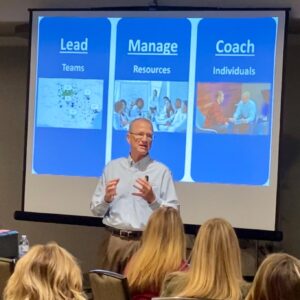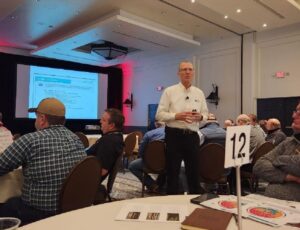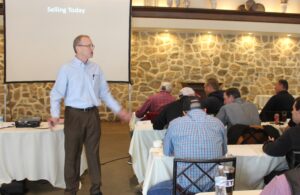Data Tells but the Story Sells
Think about this statistic…. when speaking to an audience, only 5% of the people in the room will remember a statistic after you finish your presentation. However, 63% will remember a story you told.
Don’t believe me? Test for yourself. Which do you remember more, your 6th-grade American History class or the historical scenes from Forrest Gump? For most of us, 6th grade was so long ago, we can’t even remember the teacher’s name, let alone what she said. Why? We think it is because it was boring. Not so. It’s the simple fact of how difficult it is for our minds to remember a number or statistic. 6th-grade history lessons are often a series of facts and figures. However, if you put a story to it and personalize history as in the popular movie Forrest Gump, you can instantly and fondly recall the moments of history he went through.
Why is this so important when selling to farmers and agribusiness buyers? Because we are all convinced, we need to charge into the marketplace with all of our research-proven data and “sell value” with a proven ROI. And that’s what we all do. So, from our customer’s point of view (the farmer or agribusiness buyer), all day long he is besieged by an army of salespeople showing him how good their products are with their statistical data. Don’t misunderstand. I’m not saying data and stats aren’t important. They are important and we certainly need to have them to prove our product’s effectiveness if or when needed. However, they are just too forgettable. To win the sale, we need to get the message across to our customers AND make it stick in their memory. To accomplish this, we can use the incredible power of a fitting, well-crafted story.
Storytelling in sales is not the same as just sitting around with your friends and reminiscing. Stories that sell have a structure to them. They describe the before, during, and after. They quickly depict the struggle and the solution. Which struggle? The one your product solves and the one this customer has. Which solution? THE solution, not your solution. I think it’s important to position this as the solution that works and not refer to it as your solution. A very small difference that sends a better message.
Stop relying completely on data and start telling better stories!
Two important storytelling techniques!
- The three components needed for every sales story:
- Situation
- Solution
- Success
These are part of every sales workshop I put on. It’s not a natural-born talent for most of us. We need to learn the structure and how to build effective “Selling Stories”. While it takes a little time to learn the process and get just the right stories developed, it’s well worth it on their next sales call.
- What if I don’t have stories? The only requirement for a story is that it be true/accurate. If you are new to the company and don’t have a lot of your own stories to tell, then fear not. Check with your managers, peers, and fellow department managers. Ask them for stories on the products and services you sell. Use their stories until you have your own. I think it’s only fair to let your customers know if it’s not your exact story that you were involved in. However, if it’s your products from your company, it shouldn’t matter that it’s not your direct story.
We think in pictures:
One last bit of proof that sales storytelling is so powerful and shows how our minds are wired. Just take 30 seconds and reminisce about any significant moment in your life – your graduation, your wedding, the birth of a child, your last big sales success, something hilarious that happened on a sales call, or something completely embarrassing. Now, how did you remember it? As data, as a date on a calendar? Or did you see the actual events in your memory with vivid pictures and short mental video clips of what happened, how proud as everyone clapped for you on stage or how embarrassed you felt when you made a big mistake – actually seeing yourself turn red and seeing the looks on people’s faces? My guess is you remember the short video clips and images of it actually happening. Our minds are wired to remember stories, not sequences of numbers.
In closing, remember this. Following any presentation, I have never heard anyone say “Wow, did you see slide 46? That was amazing!” But we do hear people remembering the stories that a presenter tells. We mull these over in our minds. We see the images that were discussed by the presenter. Then we see the image of whether or not we could be in that story. If we do, then we take action. If not, we soon forget!
To find out how I work with you or your team on storytelling sales training
contact me directly at Greg@GregMartinelli.net
For more Ag Sales Training, Ag Sales Coaching, and Leading Ag Sales Teams, go to





